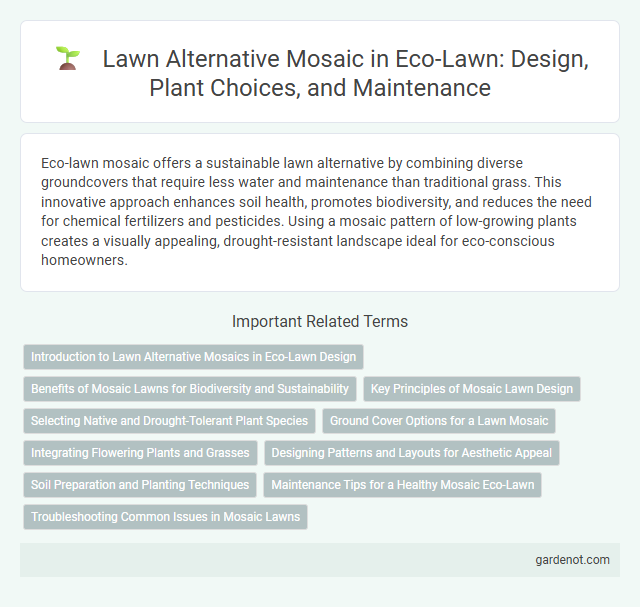Eco-lawn mosaic offers a sustainable lawn alternative by combining diverse groundcovers that require less water and maintenance than traditional grass. This innovative approach enhances soil health, promotes biodiversity, and reduces the need for chemical fertilizers and pesticides. Using a mosaic pattern of low-growing plants creates a visually appealing, drought-resistant landscape ideal for eco-conscious homeowners.
Introduction to Lawn Alternative Mosaics in Eco-Lawn Design
Lawn alternative mosaics in eco-lawn design integrate diverse plant species, creating a sustainable ground cover that reduces water usage and maintenance. These mosaics typically combine drought-tolerant grasses, clover, and wildflowers to enhance biodiversity and soil health. Utilizing lawn alternative mosaics supports eco-friendly landscaping by promoting resilience against pests and environmental stressors while maintaining aesthetic appeal.
Benefits of Mosaic Lawns for Biodiversity and Sustainability
Mosaic lawns enhance biodiversity by incorporating a variety of native grasses and wildflowers, creating habitats for pollinators and beneficial insects. They require less water and fewer chemical inputs compared to traditional turf, promoting sustainability and reducing environmental impact. These diverse plantings improve soil health and resilience, supporting ecosystem balance in urban and suburban landscapes.
Key Principles of Mosaic Lawn Design
Mosaic lawn design incorporates diverse plant species to create a textured, low-maintenance, and eco-friendly alternative to traditional turfgrass. Key principles include selecting drought-resistant groundcovers, optimizing plant height variation to improve biodiversity, and arranging species to maximize sun exposure and water efficiency. This approach enhances soil health, supports pollinators, and reduces the need for chemical inputs and frequent mowing.
Selecting Native and Drought-Tolerant Plant Species
Selecting native and drought-tolerant plant species for eco-lawn mosaics enhances resilience and reduces water consumption. Native plants adapt to local soil and climate conditions, promoting biodiversity while minimizing maintenance. Choosing drought-tolerant species ensures sustainability by conserving water resources and supporting pollinators.
Ground Cover Options for a Lawn Mosaic
Ground cover options for a lawn mosaic include drought-tolerant plants such as creeping thyme, clover, and sedum, which create a resilient, low-maintenance alternative to traditional grass. These plants enhance soil health, reduce water usage, and support pollinators, making them ideal for eco-friendly landscapes. Incorporating diverse textures and colors in a lawn mosaic fosters biodiversity while providing an attractive and sustainable ground cover solution.
Integrating Flowering Plants and Grasses
Eco-lawn alternatives that integrate flowering plants and grasses create a biodiverse mosaic, enhancing soil health and supporting pollinators like bees and butterflies. Combining native wildflowers such as black-eyed Susans and purple coneflowers with drought-resistant grasses reduces water usage and maintenance requirements. This sustainable planting strategy promotes resilience, increases habitat value, and contributes to vibrant, year-round greenery.
Designing Patterns and Layouts for Aesthetic Appeal
Eco-lawn alternatives, such as mosaic lawn designs, emphasize the use of varied grass species and drought-resistant plants arranged in geometric or organic patterns to enhance visual interest and reduce water consumption. Strategic layout planning incorporates contrasting textures and colors to create dynamic outdoor spaces that maintain ecological balance while providing year-round aesthetic appeal. Integrating pathways and native shrubbery within mosaic patterns further elevates both functionality and biodiversity in sustainable lawn alternatives.
Soil Preparation and Planting Techniques
Soil preparation for eco-lawn mosaic involves thorough aeration and enriching the soil with organic compost to enhance moisture retention and nutrient availability. Planting techniques emphasize using drought-resistant groundcovers and native grass species arranged in interlocking patterns to create a low-maintenance, sustainable green space. Proper seed selection and timely watering ensure strong root development and long-term resilience in diverse environmental conditions.
Maintenance Tips for a Healthy Mosaic Eco-Lawn
Mosaic eco-lawns thrive with minimal water and fertilizer, promoting sustainability while maintaining lush greenery. Regular mowing at a higher blade height encourages deep root growth and prevents weed invasion, enhancing the lawn's resilience. Periodic aeration and targeted watering during dry spells optimize soil health and ensure vibrant patchwork patterns throughout the season.
Troubleshooting Common Issues in Mosaic Lawns
Mosaic lawns, a sustainable lawn alternative, often face issues such as uneven growth, patchiness, and pest infestations due to the variety of grass species used. Proper soil preparation, regular aeration, and selecting the right mix of drought-resistant and shade-tolerant grasses significantly reduce these problems. Monitoring moisture levels and addressing fungal diseases promptly ensures a healthy, vibrant mosaic lawn with minimal maintenance.
Lawn alternative mosaic Infographic

 gardenot.com
gardenot.com